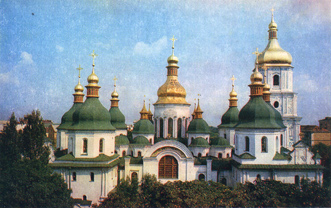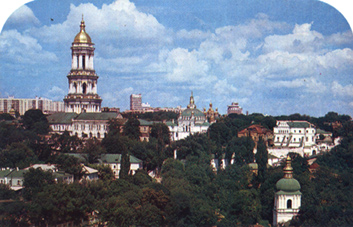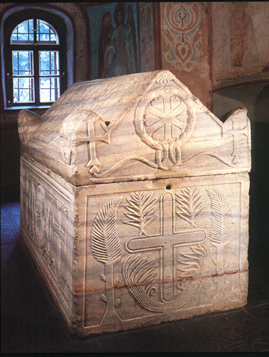| Go On Master Page | |
| THE HISTORICAL AND CULTURAL MONUMENTS OF KIEVAN RUS | |
 |  |
| Kiev. The St. Sophia Cathedral. 10th – 11th cc. | The Kiev-Pechersk Lavra. Museum of history. |
On the high hilly bank of the wide and deep Dnieper, immersed in picturesque verdure, the city of Kiev, famed capital of ancient Rus, cradle of three fraternal peoples – the Russian, the Ukrainian and the Byelorussian, – has been growing and developing for over a thousand years. Kiev, one of the most beautiful cities of the Europe, is the capital of Ukraine. Throughout the many centuries of its existence, Kiev has been distinguished by the scope and interest of its history. Numerous objects of material culture, discovered by archaeologists in excavations in the vicinity of the present Historical Museum, furnish evidence that the city had its beginning in ancient times According to the Old-Rus chronicles, the city received its name from the legendary Kiy, fist Prince of the Polyani, who – with his brothers Shchek and Khoriv and his sister Lybed – founded the first walled city on a high hill and began to reign in it. Kiev was situated on what was at the time one of the most important waterway trade routes connecting the North with the South. As early as the VIII-IX centuries it had already become a large handicraft, trade and administrative centre of the Polyani, who maintained close ties with the Drevlyani, Severyani, Radinichi, Dregovichi, Vyatichi, Volynyani and other Slavic tribes. Slavic, Byzantine, Norse, Arabian, Armenian and other merchants brought a great variety of goods to Kiev. A bustling trade always went on at the Kiev markets. Slavic merchants in their turn travelled to Byzantium by way of the Dnieper and the Black Sea (then called the Russian Sea). By river and land routes they made their way to the remote shores of the Baltic and Caspian. The development of agriculture and handicraft, the extension of trade and cultural relations between the various East-Slavic tribes, and the urgency of a joint struggle against Foreign invaders induced these tribes to unite. Kiev became the centre joining all the detached East-Slavic tribes. A united Old-Rus state was created in the IX century with Kiev as its capital. In the reign of Vladimir (circ. 978-1015) Kiev Rus was a powerful feudal state. Kiev was one of Europe's largest cities. The Old-Rus capital developed and gained strength rapidly. The centre of Kiev was situated on a high hill and occupied the area between the present sites of the funicular railway, Bolshaya Zhitomirskaya Street and Sennaya Square, extending on the North to the steep slopes of the hill. After the Russian people had accepted Christianity, the large, brick Dyesyatinnaya (Tithe) Church was erected in 989-996. The church was decorated with mosaic work and frescos. The palaces of the reigning prince and the mansions of the nobles stood near the Tithe Church, and further on stood the houses of usurers, clergymen, merchants and tradesmen.In the first half of the XI century, during the reign of Yaroslav the Wise (1019-1054), Kiev grew into a large centre of handicraft, trade, culture and art, renowned far beyond the borders of Europe. | |
 |  |
| Kiev. The St. Sophia Cathedral. Marble sarcophagus of Yaroslav the Wise. 10th – 11th cc. | Kiev. The monument to Vladimir. |